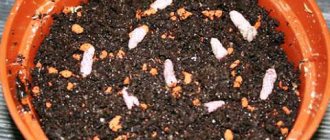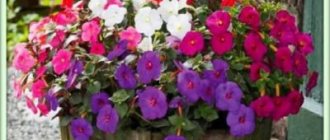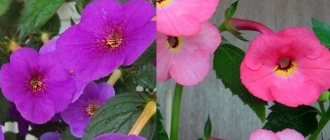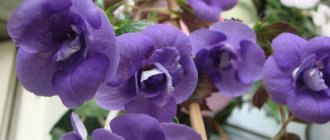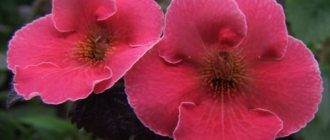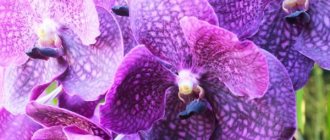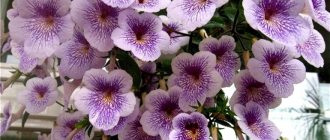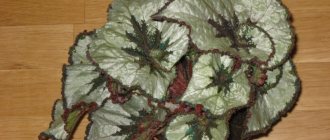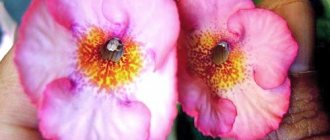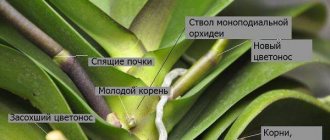Achimenes Yellow English Rose flowers are especially popular among gardeners. Today, breeders have developed a huge number of varieties that differ from each other in the color of not only flowers, but also leaves. Also, the types of Achimenes differ from each other in the type of shoot. Thus they can be erect and ampelous. The advantage of these beautifully flowering plants is that they are relatively easy to care for. With proper flowering, such tropical perennials will delight you with their bright flowers for a long time and abundantly. This article will discuss only a few of them. Below are photos and varieties of Achimenes.
Achimenes flowers: types, varieties
Achimenes is a beautiful indoor flower, very easy to care for.
Flower shapes have two types:
- Long pipe finish.
- Bowls with five blades.
Achimenes belong to the Gesneridae family, their closest relative is Gloxinia. Flower varieties are so diverse that they are further divided into groups:
- Height type:
- Erect (Erecta). They have tough shoots that shoot upward. Suitable for decorating window sills and shelving.
- Ampelous (Longiflora, Cattleya). Due to the presence of flexible shoots, the flowers seem to hang down. That is why they are often placed in hanging flowerpots.
- Flower size (diameter in parentheses):
- Small-flowered (up to 3 cm).
- Medium-flowered (from 3 to 4.5 cm).
- Large-flowered (over 4.5 cm). The most famous varieties are Rose, Kim Blue, Ring of Winsdor, Bright Rose.
- Flower type:
- Terry (Abendrot, Alter Ego, Bianco Natale).
- Simple (Aquamarine, Apple Cider, Argentina). Note that terry varieties began to appear quite recently. Breeder Serge Salibe took an active part in this process. Nuance! Simple varieties bloom more abundantly than double varieties.
- Color palette:
- Blue and light blue (Aquamarine).
- Pink and coral (Little Beauty, Pink Beauty).
- Red and scarlet (Master Ingram, Flamingo).
- Purple and lilac (Chiapas, Haage, Purple King).
- White (Juaregia, Schneewitschen, Snow Queen).
- Yellow and ivory colors (Yellow Beauty, Paul Arnold, Clouded Yellow).
Plants are seasonal, so it is extremely important to provide them with dormancy during the colder months. Flowering is long lasting, lasts from early summer to autumn
Rules for caring for Achimenes
Description of ferocactus, conditions for its cultivation and types
The rules for caring for the achimenes flower are not too complicated. It does not tolerate strong temperature changes, low air humidity, or cold drafts. Otherwise, the plant causes virtually no trouble.
- Optimal temperature. From the moment the rhizome (scaly rhizome in the form of a nodule) awakens, throughout the entire growing season and flowering it is necessary to maintain a temperature of about +22...23°C. In autumn, when the rhizomes begin to prepare for dormancy, the temperature is gradually reduced to +15°C.
- Lighting. Achimenes love bright light, but do not tolerate direct sunlight. Sensitivity to light largely depends on the variety. Plants with variegated leaves are more susceptible, so it is recommended to shade them. Varieties with dark leaves tolerate moderate amounts of direct sunlight without harm. Both of them will feel great on windows on the western side, but on the southern side it is better to shade them slightly. If possible, pots with plants can be taken outside or onto an open balcony.
- Watering. During the growing season, flowers require abundant watering. But you need to make sure that there is no stagnation of water. Holes are made at the bottom of the pot to ensure good drainage. The flower does not like water getting on it, so watering is carried out directly under the root or in a tray. The water temperature for irrigation should be slightly higher than room temperature. During the flowering period, watering is carried out every 3 days, after its end - their frequency gradually decreases.
- The soil. Rhizomes of Achimenes are planted in fertile, light, breathable soil. You can buy ready-made soil for Saintpaulias or prepare it yourself. The optimal ratio is one part of peat, perlite or coarse sand and humus. It will be useful to add a little hydrogel or finely chopped sphagnum to the finished substrate so that the soil is consistently moist. Achimenes respond well to adding a small amount of cow manure to the soil.
- Spraying. Plants cannot be sprayed. If water drops on the leaves, it will leave brown spots on them. To increase humidity, spray the air only around the plant, making sure that moisture does not fall on the leaves. You can use another option - pour a little water into a container, cover it with pebbles and place the pot with the plant on top so that its bottom does not touch the water.
- Feeding. For the first time during the season, the flower is fed only 3-4 weeks after the first shoots appear. Complex mineral fertilizers are used. While Achimenes is blooming, fertilizing is repeated every two weeks. After flowering ends, they stop completely. Abundant and frequent fertilizing can reduce the intensity of flowering, so using mineral fertilizers more than twice a month is not recommended.
- Dormancy and pruning. From mid-autumn, the leaves of Achimenes begin to gradually dry out. At this time, rhizomes collect nutrients, drawing them from the soil and leaves, so pruning is carried out only after the above-ground part of the plant has completely dried. The pot with rhizomes is put away for the winter in a dark place with a temperature of about +15°C. In winter, the soil is moistened very moderately and no more than once a month. It is carefully moistened with well-settled water along the edge of the pot. High humidity can cause rhizomes to wake up prematurely.
If Achimenes “woke up” ahead of time, then for its normal development it is necessary to provide good lighting with fluorescent lamps.
Growing
In order for your pet to enjoy its successful appearance, it needs the following care at home. During growth, there should be a moderately warm temperature - in summer from +23 to +26 ° C. Flowerpots can be placed on the balcony or kept near an open window, since warm drafts are not scary for it. But the slightest coolness can damage this plant. If the temperature drops to +15° C, then growth slows down and it prepares for wintering.
In winter, it needs a period of rest - it goes into hibernation at a temperature of +10° C. In autumn, the above-ground part of the plant dries out, and the entire supply of nutrients accumulates in rhizomes (rhizome tubers). After flowering has finished, the plant is prepared for hibernation by gradually reducing its watering.
During the growth period, it loves a large amount of diffused light, but it needs to be shaded from direct sunlight.
Proper care of a handsome man also implies a good supply of moisture. You need to water with water slightly above room temperature. But the adult specimen does not like spraying - spots appear on wet leaves. It is enough to humidify the air near the shoots, or place containers of water nearby. This will stimulate better flowering and also improve overall development.
Varieties
Achimenes cote d'ivoire
Ficus benjamina: photo, description, growing conditions, home care
It was obtained as a result of selection by Serge Saliba in 2007. It has rich and varied semi-double flowers with a border. The name of the hybrid speaks for itself. They are medium in size, ivory, soft yellow with light lilac spots on the petals.
Achimenes hard to get
The name translates as “difficult to obtain.” Most likely, they had to work hard on him during selection, since he received such a name. With good fertilizer, rich in phosphorus and potassium, and regular watering, you will get double pink-raspberry or cold cherry flowers with yellow strokes and crimson dots around the throat.
Achimenes glory
A small, hybrid, compact plant, characterized by excellent and long-lasting flowering. Bright large coral-red colors with light centers will definitely delight you with their beauty if you install it on the windowsill in your room.
Achimenes amie saliba
The hybrid appeared 6 years ago, but continues to be popular. It looks like a neat bush. Its flowers are large, sunny, “canary-like”, the edges of the petals are pink. The leaves are light green.
Achimenes strawberry lemon
The name of this miracle translated means “strawberry-lemon” and successfully states its appearance. It looks very beautiful when lemon yellow and soft strawberry colors smoothly flow into each other; over time, the petals can acquire shades of peach and salmon. It depends on the growing conditions.
Achimenes charm
“Charm” refers to hanging plants. The height of its weakly branched erect stems reaches 60 cm. It looks rich with large and bright flowers measuring 4-6 cm in diameter. The corolla is coral-pink with an expressive amber spot, as well as a red-brown speck at the throat. If you provide it with the maximum possible lighting, fresh air and abundant watering, then it will definitely please you, especially in hanging flowerpots.
Achimenes sauline
It is very beautiful, thanks to its small, pale yellow flowers. Along the edges of the slightly wavy petals there is a fuchsia border. The closer to the center, the lilac dots and strokes underlying the golden color become less noticeable. It may fade in bright sun, so it is recommended to keep the flowerpot in partial shade.
Achimenes blueberry lemon
Due to the impressive size of the bush, it requires supports. Its flowers are soft lilac, with a yellow center. The name translates as “Blueberry Lemon”. Depending on the conditions of detention (temperature during flowering, feeding), dominance of one or another tone is possible. An additional petal may form in the throat.
Achimenes pink double
Bush variety. The flower is very delicate, despite its rather large size, up to 5 cm, which is above average. It looks voluminous, terry and can have a range of colors from pale pink to rich pink with a creamy yellow spot in the center.
Achimenes golden lady
Created in 2007, a bush semi-double variety with interesting dark burgundy stems. Gives the impression of a calm color thanks to the light yellow flowers with an admixture of lilac shades at the edges. Medium size and pastel colors. Color may vary depending on temperature. Around the center, where an additional petal sometimes forms, is golden yellow.
Achimenes rainbow warrior
Interesting name, translated means “Warrior of the Rainbow”. It looks very attractive, you want to look at and notice all its nuances. There are specimens with 6 cm buds. Their color varies from lilac to purple. Closer to the middle there are strokes and shadows of cherry, burgundy or dark brown shades. The variety is powerful and tall. You can grow it in an ampoule, but if you are going to use a pot, be sure to choose a stable one.
Achimenes peach glow
Received it as a result of selection of R. Brumpton in 1980. “Peach Blush” has small simple flowers, one might even say small, about 2.5 cm, of a peach hue with a golden throat, the edge of the petals is decorated with carvings.
Achimenes varieties by color
For example, for those who want to grow bushes with yellow flowers, you can pay attention to the following varieties:
- Achimenez Sun Dance. A peculiarity of this species is the presence of an original brown-red speck located in the central part of the bud;
- Jimenez "Giselle" Giselle.
Varieties whose buds are colored lavender and purple include:
- Achimenes Avender Fancy (“Lavender Fancy”);
- Tropical Dusk (“Tropical Dusk”);
- Daisy Boo (“Daisy boo”);
- Peach Blossom;
- Snoweetta;
- Hugues Aufray;
- achimenez lavender fancy;
- Achimenes Venice (“Venice”);
- Achimenes Poseidon “Poseidon”;
- Vivid (“Vivid”);
- peach blossom;
- purple kimono.
Varieties whose inflorescences are colored pink include:
- Achimenes Sabrina;
- achimenez Painted Lady;
- Achimenes Peach Glow (“Peach Glow”);
- Veronika Gotmanova "Veronica".
Varieties whose buds are colored red include:
- Achimenes red Stan`sa Delight (“Stans Delight”);
- Lady in Black
The name of the variety is translated from English as “Difficult to get.” The hybrid has a very variable flower from single to double, with colors ranging from cold cherry to variegated. Bushy, profusely flowering!
information about order
What is Achimenes, description, photo
Achimenes
Achimenes Pers belongs to the Gesneraceae family and is a relative of the well-known and very decorative Saintpaulias, Gloxinias, and Streptocarpus.
In nature, Achimenes most often grow in the mountains, starting from 300 meters and ending at 2300 meters above sea level. They can settle in rock crevices, but most prefer soils in tropical forests and along river beds. There is almost as much shadow in their habitats as there is sun. The climate here has a clear division into dry and wet seasons, which determines the characteristics of the growing season of plants.
When kept in a room, Achimenes behaves in the same way as in nature: it has a period of active growth, which begins at the end of February, beginning of March, and a dormant period, which lasts from the end of October to the end of February. In general, the dormant period lasts from four to six months. In old varieties it is longer than in new hybrids.
Planting Achimenes
Preparing soil and containers
Achimenes require light, fertile, breathable soil. Typically, for planting, a ready-made substrate for Saintpaulia is used, with the addition of various loosening components - perlite, vermiculite, coconut substrate, as well as finely chopped moss - sphagnum or hydrogel - to maintain soil moisture.
Rhizomes are planted in a pot one at a time, but more often in groups of several pieces, then you can get a more “richly” flowering plant.
To plant one rhizome, you need to select a pot with a volume of at least 0.7 - 1 liter, if there are several rhizomes, then even more. The pots need to be wide, because Achimenes have a shallow root system.
Planting of Achimenes rhizomes is usually carried out in early spring, and at this time the active sowing period begins - transplanting seedlings and indoor flowers. Therefore, to save space on the windowsill, rhizomes can be planted first in a small container, and as they grow, transfer the plants.
It is necessary to put drainage at the bottom of the pot to avoid stagnation of moisture.
Planting dates for rhizomes Achimenes
Achimenes are usually planted with sprouted rhizomes (with sprouts).
This process usually begins in February - March. During this period, the daylight hours are already long enough and young plants begin to grow and develop well.
But it happens that rhizomes begin to emerge from dormancy much earlier - mid-to-late December. In this case, you need to reduce the storage temperature of rhizomes to +5...+8o. C, then the seedlings will stop growing.
You can plant early sprouted rhizomes of Achimenes, but only with the condition that the plants must be provided with additional lighting.
Planting Achimenes rhizomes step by step
- To prevent problems in the development of Achimenes, it is advisable to soak the rhizomes in a fungicide solution before planting. For example, “Fitosporin” or a weak solution of potassium permanganate.
- The planting material must be spread horizontally over the soil surface, and then covered with a 0.5-2 cm layer of soil. The larger the rhizome, the larger the soil layer.
- There is no need to cover rhizomes with film.
- After planting rhizomes in pots, they need to be provided with bright, diffused lighting, air temperature +18...+250C, and moderate watering.
- The appearance of Achimenes sprouts from the ground usually begins after 2-3 weeks.
- If sprouts do not appear for a long time, then to stimulate germination you can water with warm water (50-55 degrees) or a solution of a growth stimulator (Zircon, HB-101, etc.).
Estimates
Leave a review “Hard to Get” Cancel reply
- Tatyana / 06/02/2019: I placed an order last year, now my achimenes have bloomed, but not all of them yet. Very beautiful, I have made a pre-order for other varieties, I hope to receive this one. »
- Svetlana Davydova / 04/19/2019: I received the parcel. Everything arrived perfectly. Thank you for the fast delivery. »
- Galina / 04/07/2019: I received the package, very pleased. Packed so carefully and practically. Thanks a lot. And instructions are included. »
- Tamara Demina / 03/27/2019: [Review moved from the VKontakte group] HELLO, TODAY I RECEIVED A PACKAGE WITH RHIZOMES OF ACHIMENES, I WANT TO SAY A HUGE THANK YOU, THEY WRAPPED THE PACKAGE CONSCIOUSLY, THE RHYZOMES HAVE ALREADY AWAKENED SUCH A CHARM. »
- Nadezhda Babaeva (Bogdanova) / 03/27/2019: [Review moved from VKontakte group] Hello. And here is my first order. I was afraid for a long time, looked closely at the Achimenes, then took a long time to choose. Thanks to the entire team of the World of Achimenes. »
The minimum order amount is 1000 rubles! Delivery regions: throughout Russia, Belarus and Kazakhstan.
Care
At home, it is very easy to provide Achimenes with complete care. It provides for the creation of such conditions for plants as:
- soft and sufficient lighting throughout the day;
- optimal temperature;
- regular but moderate watering;
- sufficient humidity and air ventilation;
- fertilizing with complex fertilizers during the period of intensive development;
- quality soil.
Illumination
Achimenes are sensitive to light deficiency, so the best place for them is window sills in the western and eastern parts of the home. On a window in the northern part the plant will not have enough light, and in the southern part it may become a victim of direct sunlight.
Temperature
These exotic plants love warmth and do not tolerate cold weather and temperature changes. Even a drop in air temperature to 20° can cause achimenes significant discomfort.
The optimal temperature range for keeping these delicate plants is considered to be 22-25°. At this temperature, Achimenes will feel normal both on the balcony and on the open terrace
However, when keeping plants on the balcony or outside, it is important to monitor meteorological forecasts. At the first threat of night cold, flowers must be brought into the house
In winter, when the plants are in the dormant phase, it is advisable to maintain the temperature at 18-19°. For Achimenes, which are in a state of winter sleep, this temperature range will not cause stress.
Watering
These beautifully flowering perennials do not tolerate drought or excess water well. A lack of moisture in their case can stop flowering, and an excess of it in the soil can cause rotting and death of the roots.
Achimenes need to be watered regularly, but only as needed. During the period of intensive development (after emerging from the winter sleep phase), plants require sufficient and moderate watering. Reduce watering of flowers as much as possible while they are in the winter dormant phase. During this period, plants are watered no more than 1-2 times a month. When watering, a stream of water is directed along the edge of the pot.
Humidity
Despite the fact that these beautifully flowering perennials do not have high humidity requirements, they do not like dry air. In order for plants to feel comfortable, gardeners recommend keeping wide containers filled with water near the pots.
Also, these flowers really need high-quality air ventilation. However, drafts are contraindicated for them
It is extremely important to provide moderate ventilation indoors during very hot weather.
Feeding
For young, actively developing and flowering achimenes, timely feeding is extremely necessary. Most often, they are carried out once every 7-10 days, using special complex fertilizers for indoor flowers. Fertilizing with Fertika Lux gives very good results.
During the formation of buds, it is recommended to feed plants with fertilizers containing phosphorus and potassium.
Fertilizing with a high nitrogen content should be applied with caution, since an excess of this element in the soil mixture can provoke vigorous development of green mass and weak budding
For very young Achimenes growing root mass, phosphorus-based fertilizers are recommended. This element plays an important role in the proper formation of roots. Typically, at this stage, flower growers use the “Rikat Start” product.
Priming
These flowers feel most comfortable in a loose and nutritious soil mixture with good moisture and air permeability. It is allowed to grow Achimenes in peat-based substrates. Ordinary soil mixed with coarse sand or perlite is also suitable.
Watering Achimenes
Achimenes are quite moisture-loving and it is advisable to use drainage when watering. Water for irrigation should be no lower than room temperature (even a little warmer) because if Achimenes feels cool (+15 degrees), it will immediately begin to prepare for winter dormancy, and at +10 the leaves begin to die off and go into “hibernation.”
Do not allow the soil to dry out! It is worth paying attention to the fact that, despite its moisture-loving nature, an adult plant does not like direct wetness. For refreshment, it is recommended to spray water around.
Care errors and their elimination
The table contains frequently encountered problems when growing Achimenes and their elimination:
| Problem | Causes | Solution |
| Light brown spots on leaves | Watering with cold water | Use warm, well-settled water for irrigation |
| Changing the color of the buds | The indoor air is too hot | Observe the temperature regime, do not overcool or overheat the flower. |
| Small inconspicuous flowers | Nutrient deficiency | During the growing season, regularly apply complex fertilizers |
| Brown leaf tips | Dry air | Spray the space around the flower, place the flowerpot on a tray with wet expanded clay |
| Curling leaves | Soil waterlogging | Reduce the number of waterings |
Diseases and pests
Despite the fact that Achimenes is considered a fairly resistant plant, it also gets sick. Most often, this can be ring spotting caused by watering with unsettled or cold water, as well as sunburn.
- With insufficient lighting, iron deficiency may occur, which leads to impaired photosynthesis (chlorosis - yellowing of the interveinal parts of the leaf ).
- An excess of moisture with a violation of the temperature regime (lowering) can lead to the appearance of gray rot, which manifests itself in the form of browning of leaves . In such cases, it is necessary to urgently and carefully free the plant from the affected leaves.
- Achimenes can also be affected by red spider mites . In such cases, you need to spray with special antiseptics and insecticides within the recommended time frame.
What does Achimenes look like?
Achimenes (Achimene) is a perennial herbaceous plant no more than 30 cm high. The shoots of the bush are quite fleshy, the leaves have a glossy surface, an oblong shape and a dark green hue with clearly visible veins and jagged edges. The indoor plant is distinguished by the friendly appearance of several buds at once. The flowers are small and slightly shaped like a gramophone. The root system of Achimenes develops as rhizomes - bulbs, externally covered with small scales.
Achimenes
History of appearance
In the wild, the plant is distributed in Central America and Mexico. The first written mention of it was found in the scientific works of one of the biologists who studied the flora of Jamaica. A detailed description of the flower was compiled back in 1756.
How to grow Achimenes from cuttings
The most common way to increase the number of pots with achimenes is propagation by cuttings.
To do this, cut off the top shoot or side leaf from an adult plant and plant it in the ground under film or glass.
Cuttings need to be watered regularly, it is important that the soil is always moist
For intensive growth, use enriched leaf soil mixed with sand in equal parts. Also use growth stimulants or an additional heat source. After a month, the cuttings will get stronger and need to be transplanted to a permanent place.
Achimenes is an unpretentious plant that can decorate a home in winter and a garden plot in summer. It is enough to acquire one sprout of this beautiful flower to turn your home into a real garden filled with the bright colors of Achimenes flowers.
Reproduction of Achimenes
Achimenes propagates both vegetatively and by cuttings. The first method is preferable because the sprouted plant will already have a root system, which will allow further healthy lush growth and give rise to up to a dozen new rhizomes.
While propagation by cuttings allows the plant to take root only after 2-3 months and only then will they be able to form new rhizomes, which will give rise to plants only in the next season.
Large rhizomes (they look like a mulberry fruit) can be divided when planting, but not made too small so that future plants are strong and healthy.
Features of caring for Achimenes
In order for the plant to feel good and give wonderful flowering, it is necessary to create conditions that are closest to those in which it grows in nature. Proper care and cultivation of Achimenes implies compliance with the following requirements:
Location and lighting are important for growth; The temperature regime must be observed so that the plant does not die; Proper watering and maintaining air humidity; Achimenes needs to be fed periodically.
Choosing a location and lighting features
There is enough light in the tropics, so our flower also needs bright, but diffused light. The lighting needs of different types of Achimenes are different: plants with dark leaves love more light. But they can hardly tolerate direct sunlight, and burns of buds and flowers are possible. The flower will be best placed on the windowsill of western and eastern windows, or, in extreme cases, oriented to the southwest or southeast. Protection from direct sunlight during midday is mandatory. Daylight should last from 10 to 12 hours, as in the tropics.
There are selective hybrids on sale with their own lighting preferences. They usually have young shoots of achimenes that are dark green in color. Such plants will do well even on the windowsill of a south-facing window. At different stages of development, this flower reacts to lighting differently. According to the recommendation of Serge Salib, before the formation of buds, Achimenes will be comfortable in bright sunlight. At this time, even a south-facing window will suit him. The beginning of the formation of buds is associated with relocation to a semi-shaded place, since bright sunlight is harmful for the blossoming buds.
Temperature
During the active growing season, Achimenes loves warmth, such as in its homeland. This is no less than 22-25 degrees. In summer it tolerates temperatures up to 30 degrees. But lowering it below plus eighteen is disastrous for him. It is not for nothing that the name of the flower Achimenes, translated from Greek, sounds like “not tolerant of cold.” If your pet Achimenes spends the summer outdoors, be sure to bring him inside during cold spells or cold nights. During the rest period the picture changes. At this time, the best temperature for it is from 8 to 15 degrees. At higher temperatures, Achimenes may exit the dormant state earlier, which is not desirable.
Irrigation regime and humidity requirements
The soil in the pot should be moist, but not waterlogged. If water has accumulated in the pan after watering, it must be poured out. It is better not to allow the soil to dry out. Water the achimenes only with settled water. Hard water is softened by adding a few citric acid crystals.
The temperature of the water used to water the achimenes should be two degrees higher than room temperature.
This flower is very sensitive to air humidity. It must be at least 60%. However, wetting flowers and leaves with water is unacceptable. This causes dark spots to appear on them. Therefore, spraying cannot be resorted to. You can increase air humidity by installing evaporators or placing the flower in a tray with moss soaked in moisture. It’s a good idea to spray the air around the achimenes from time to time, protecting the leaves. With the onset of the dormant period, the need for watering disappears. Only light wetting of the top layer is required once a month. During preparation for plant rest, the amount of water during irrigation and its frequency are gradually reduced.
Feeding is a necessary element of caring for Achimenes
They begin no earlier than a month after germination and continue throughout the flowering period. Feed with a complex fertilizer for indoor plants, for example, “Kemira Lux”, once every ten days: before flowering, fertilizer mixtures for ornamental deciduous plants are needed, by the time a sufficient number of leaves grow, namely at the beginning of summer, fertilizer mixtures for flowering plants are used periodically once a month.
The fertilizer mixture must contain microelements and contain calcium. With very active flowering of Achimenes, it is possible to apply fertilizer with each watering, but in a small dosage. It is good to alternate mineral and organic fertilizers. They should be given in the form of mullein infusion in a dilution of one to fifteen. In August, Achimenes should be additionally fed with potassium fertilizer, for example, potassium sulfate, the dosage is indicated in the instructions, and organic fertilizers should be abandoned, thereby reducing the proportion of nitrogen. The last feeding is carried out no later than 1.5 months before the onset of the dormant period.
Home care
Lighting
They love light and sunlight. However, you need to ensure that the leaves are not exposed to direct sunlight. Excessive heat will harm them. In the shade, Achimenes will lose its bright, rich color. Therefore, you need to find a place where the ratio of shadow and light will be normal.
Temperature
This plant is not very picky about the temperature in which it grows. However, you should place the pot only in places where the temperature rises above twenty degrees. The best temperature for full development varies from twenty to twenty-four degrees.
If the temperature on the balcony does not experience sudden changes, then this place is suitable for a flower. It is advisable to remove the plant at night. With the onset of spring, the temperature in the room may become lower. However, even during Achimenes’s sleep, it should not be lower than ten to fifteen degrees.
Humidity
It is desirable that the air is well humidified. If it is clear that the plant does not have enough moisture, additional spraying is necessary. However, you must be careful not to overdo this process. After all, excessive spraying will only do harm. Spots form on the leaves.
If it is possible to make a stand with moistened pebbles, then you should do it. Thus, the humidity will become even higher. It will be good if there is an aquarium next to the plant. The water will evaporate, which means the air will also become more humid.
Watering
- During the growing season, you need to water regularly and abundantly. After the plant wakes up. Doses of water are increased gradually. In summer, doses should be especially large. The main thing is that the water is warm.
- Care must be taken to ensure that water does not accumulate in the pan. Otherwise, this may lead to the formation of rot in the roots.
- As soon as autumn arrives, watering should be done less frequently and not so abundantly. As the leaves wilt, the amount of water should decrease. As a result, while the Achimenes flower is dormant, it should be watered no more than twice a month.
The soil
Needs loose soil. To make the correct mixture, you need to take three parts of leaf soil, add two parts of turf soil and cover with one part of sand. You can put a little peat and humus. They will be useful.
If there are no components from which such a mixture could be prepared, you need to go to the store and buy achimenes soil for ornamental crops. Before planting the plant, drainage must be done.
Transfer
If it is necessary to replant the plant, it is advisable to carry out this procedure at the end of February. Just at this time, Achimenes is just waking up. Rhizomes must be laid down and covered with soil. The height of the substrate level should not exceed half a centimeter.
Fertilizer
Only those achimenes that have begun to bloom need to be fed. The procedure should be carried out no more than twice a month. Moreover, if the plant began to bloom immediately after it was transplanted, you need to wait some time and only then start fertilizing.
Rest period
In autumn, the leaves of the plant turn yellow and fall off. This is a sign that the plant is preparing for sleep. Watering should be done less frequently. Everything that has dried up and died must be cut off. The roots are left in the same place. It is necessary to moisten the soil no more than once a month. At the beginning of March, containers with roots are returned to their original sunny place.
Maintaining humidity, how to water Achimenes
Humidity in the room. Humidity conditions when caring for Achimenes at home are very important. Air humidity should be high, since the plant naturally grows in a tropical climate. However, you should never spray the leaves of the flower. Humidity is increased by spraying air around the pot. It is also worth placing a tray with wet expanded clay or pebbles under it. The bottom of the pot should not come into contact with the water in the pan. Moisture getting on the foliage can cause problems. Brown spots may appear on the leaves.
During the growing season, caring for Achimenes flowers should include abundant watering. To do this, you need to let the water sit until it becomes soft. When watering, you need to control the amount of moisture in the soil. The roots should not be constantly in excessively wet soil.
As already mentioned, caring for the Achimenes flower at home should be careful. Leaves should not be watered. This harms the plant. Watering is best done with a syringe or using bottom watering through a tray. It is advisable that the water have a temperature slightly above room temperature.
Description
Achimenes is native to the American continents. Since the end of the 18th century, the plant was brought to Europe from the Caribbean islands. In the 19th century, the flower was actively selected, and by the beginning of the 20th century many hybrids had appeared. Nowadays, agronomists continue to work on developing new varieties, the Romanian scientist Serge Saliba was especially successful, who bred about 200 species of this beautiful plant.
Achimenes are perennial flowers of the Gesnerieceae family, with thin drooping stems, some varieties have an erect stem. For example, the only species that does not grow in America, but in South India, is endowed with just such a stem. The leaves are pubescent, with a rich color at the bottom. Single and paired inflorescences are fixed in a thin five-leaf calyx.
Achimenes suspend their vital activity, freezing from mid-autumn to early spring (for 4-6 months), when daylight hours become short. In this case, the ground part completely dies off. They reproduce by rhizomes, which are small scaly shoots that resemble very young fir cones. The plant does not have underground tubers, and rhizomes, appearing on the rhizome, play the role of seeds in the reproduction process. From late winter to mid-spring, young shoots appear, the first harbingers of “awakening”.
Botanical description
The plant is perennial, the roots are scaly. Flowers are paired or single. All plant species have pubescence. The stems may be branched and the leaves may have serrations, depending on the variety. After opening, the flowers quickly wither, but new buds appear in their place. Different colors: purple, pink, red, yellow and others.
Flowers may have patterns in the form of dots, stripes or specks.
Used in the interior as an hanging plant, in hanging baskets and wall planters.
How to store Achimenes rhizomes in winter
Achimenes can be harvested for the winter only after the above-ground part has died off. It will not fade or turn yellow, but will become completely dry.
Achimenes overwinter at temperatures not lower than 10 °C. They cannot be placed in the refrigerator. The optimal temperature during the resting period is considered to be 12 °C, but it is difficult to achieve it in a city apartment.
The flower survives well from year to year in warmer conditions. The main thing is not to place it near heating devices, or in a place with high humidity. Still try to keep it cool.
To preserve Achimenes rhizomes until spring at a room temperature of 18-20 ° C or higher, they need to be watered once a month. A little, so as not to wet, but only slightly moisten the surface of the soil. Otherwise, the rhizomes will dry out very much and may not wake up.
A temperature of 18-20 °C is far from optimal, and if it is higher, only a few of the largest rhizomes from the collection can survive if kept completely dry.
Overwintering of Achimenes in the ground
The easiest way to preserve Achimenes rhizomes is directly in pots in winter. They are placed in a cool, dark place. And they forget until February. Of course, if the winter is really cool. Otherwise, the pot needs to be watered occasionally and little by little.
Sometimes at the end of the season the rhizomes protrude from the substrate. They cannot be left open. A 1.5-2 cm layer of dry peat should be poured on top.
If you plan to plant flowers, it is not recommended to wait for the sprouts to peck. They are dug up in early February and moved to new pots.
The easiest way to store Achimenes rhizomes is in the same pot where they grew.
Storing rhizomes of Achimenes outside the ground
It is difficult to leave a large collection in pots for the winter - it is not clear where to put them. Of course, if there is an insulated loggia, balcony or barn where the temperature does not drop below 10 °C, there is no problem. Otherwise, you will have to dig up the rhizomes, wash them, rinse them in a fungicide solution, dry them, and place them in containers or bags with filler. And only after that send him to rest.
For storage you can use:
- clean dry sand;
- peat;
- fine perlite;
- vermiculite
Every month you will have to check the safety of the rhizomes, ventilate them, and, if necessary, remove or treat diseased ones. In February, Achimenes rhizomes are planted in fresh soil.
Achimenes stored in bags must be labeled
Reproduction
Three methods are used:
- cuttings;
- dividing the rhizome;
- seeds.
But the seeds do not transmit parental varietal characteristics.
If you divide the rhizomes, then you should not cut them into too small parts - the sprouts from them come out weak and do not bloom well. Cuttings can be rooted from early summer to mid-summer. To do this, you can use either a light substrate, moistened coarse sand, or just water.
Caring for Achimenes
In order for Achimenes to bloom on time and abundantly, they require suitable conditions and good care.
Lighting
The best location for achimenes will be a western or eastern window. In the south, it is better to shade the leaves from the sun during the daytime.
In the northern part of the house or in the back of the room, the shoots will quickly stretch out from lack of light, and flowering may be completely absent.
Temperature
Its heat-loving nature is reflected even in its name: from Greek “ahimenes” is translated as “afraid of the cold.” But the flower does not like heat either: the optimal temperature in summer is considered to be 20...22 °C.
At temperatures above 27 °C, the condition of the corollas worsens, they become smaller and change their color.
In winter, rhizomes are stored at a temperature no higher than 15 °C.
Priming
For fast-growing and abundantly flowering achimenes, soil nutrition is important. The soil should have good air permeability and a slightly acidic reaction.
Of the ready-made substrates, the composition for Saintpaulia has suitable characteristics, which can be supplemented with pieces of coal, moss and brick chips.
When preparing the soil yourself, you need to mix sand, peat and humus in equal volumes and add the same amount of leaf soil.
Before planting rhizomes, the soil is heated in the oven or frozen in the freezer to destroy pathogenic microorganisms and fungi.
Achimenes pot
The main part of the roots of Achimenes is located superficially, so the pot for the flower is chosen to be wide and shallow. For hanging varieties, any flower pot that is hung against the wall or placed on a high shelf is suitable.
The material of the pot can be anything, the main thing is that there are wide drainage holes at the bottom to quickly drain excess water.
Watering
Achimenes should be watered regularly, especially in the summer when there are an abundance of flowers. At least once every 3 days, moisten the soil with well-settled water slightly warmer than room temperature. Watering is carried out early in the morning or after sunset.
It is important to ensure that water does not get on the delicate leaves. If this happens, then immediately blot the drops with a paper napkin.
Feeding
Achimenes need constant feeding to survive. From the moment the rhizome germinates, liquid fertilizers for Gesneriaceae or any universal remedy for indoor plants are applied at least 3 times a month.
Until mid-spring, you can add fertilizers with a predominance of nitrogen, which will accelerate the growth of green mass. By summer, you need a mineral complex with potassium and phosphorus. Ready-made fertilizers for flowering plants are usually sold with this composition.
During flowering, the amount of fertilizing increases to weekly.
Advice! Experienced gardeners recommend adding fertilizer in a minimal dose during each watering, which results in even more luxuriant flowering.
Transfer
In order for the flower to have enough nutrition for the new season, it is recommended to transplant the rhizomes into a new substrate after wintering:
- In February, the rhizomes are removed from the soil and cleaned of damaged parts.
- You can use the same pot, cleaned and rinsed well with boiling water, or take a new one. Cover the bottom with drainage.
- Cover with soil almost to the top, leaving 5 cm free to the top edge of the container.
- Water and place the rhizomes horizontally, using slight pressure to deepen them by half a centimeter.
- Pour another 1–1.5 cm of soil on top and spray with a spray bottle.
The pot is placed in light at a temperature of 25 °C. Sprouts begin to appear after 2 weeks.
